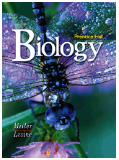BIOLOGY
by Miller & Levine
[complete Table of Contents]

|
Use the pull-down menu to jump to any of the Book's 40 Chapters: |
Additional Resources:
Antibiotics
in Animal Feeds.
Are they Dangerous?
(Issues in Biology)
![]() Chapter 16
Chapter 16 ![]()
The Evolution of Populations
In this chapter, students will read about how genetic diversity and changes in the genetic makeup of populations contribute to evolution. Students will also read about types of and mechanisms of natural selection and the process of speciation. The links below lead to additional resources to help you with this chapter. These include Hot Links to Web sites related to the topics in this chapter, the Take It to the Net activities referred to in your textbook, a Self-Test you can use to test your knowledge of this chapter, and Teaching Links that instructors may find useful for their students.
| Hot Links | |
| Take it to the Net | Teaching Links |
What are Web Codes? |
Web
Codes for Chapter 16: Antibiotics in Animal Feed (Issues) SciLinks: Population Genetics SciLinks: Speciation Self-Test |
![]()
Section
16-1: Genes and Variation
![]() Biologists have
discovered that there are two main sources of genetic variation: mutations
and the genetic shuffling that results from sexual reproduction.
Biologists have
discovered that there are two main sources of genetic variation: mutations
and the genetic shuffling that results from sexual reproduction.
 The number of phenotypes produced for
a given trait depends on how many genes control the trait.
The number of phenotypes produced for
a given trait depends on how many genes control the trait.
Section
16-2: Evolution as Genetic Change
 Natural selection on single-gene traits
can lead to changes in allele frequencies and thus to evolution.
Natural selection on single-gene traits
can lead to changes in allele frequencies and thus to evolution.
 Natural selection can affect the distributions
of phenotypes in any of three ways: directional selection, stabilizing
selection, or disruptive selection.
Natural selection can affect the distributions
of phenotypes in any of three ways: directional selection, stabilizing
selection, or disruptive selection.
 In small populations, individuals that
carry a particular allele may leave more descendants than other individuals,
just by chance. Over time, a series of chance occurrences of this type
can cause an allele to become common in a population.
In small populations, individuals that
carry a particular allele may leave more descendants than other individuals,
just by chance. Over time, a series of chance occurrences of this type
can cause an allele to become common in a population.
 Five conditions are required to maintain
genetic equilibrium from generation to generation: there must be random
mating; the population must be very large; and there can be no movement
into or out of the population, no mutations, and no natural selection.
Five conditions are required to maintain
genetic equilibrium from generation to generation: there must be random
mating; the population must be very large; and there can be no movement
into or out of the population, no mutations, and no natural selection.
Section
16-3: The Process of Speciation
 As new species evolve, populations become
reproductively isolated from each other.
As new species evolve, populations become
reproductively isolated from each other.
 Speciation in the Galápagos finches
occurred by founding of a new population, geographic isolation, changes
in the new population's gene pool, reproductive isolation, and ecological
competition.
Speciation in the Galápagos finches
occurred by founding of a new population, geographic isolation, changes
in the new population's gene pool, reproductive isolation, and ecological
competition.
